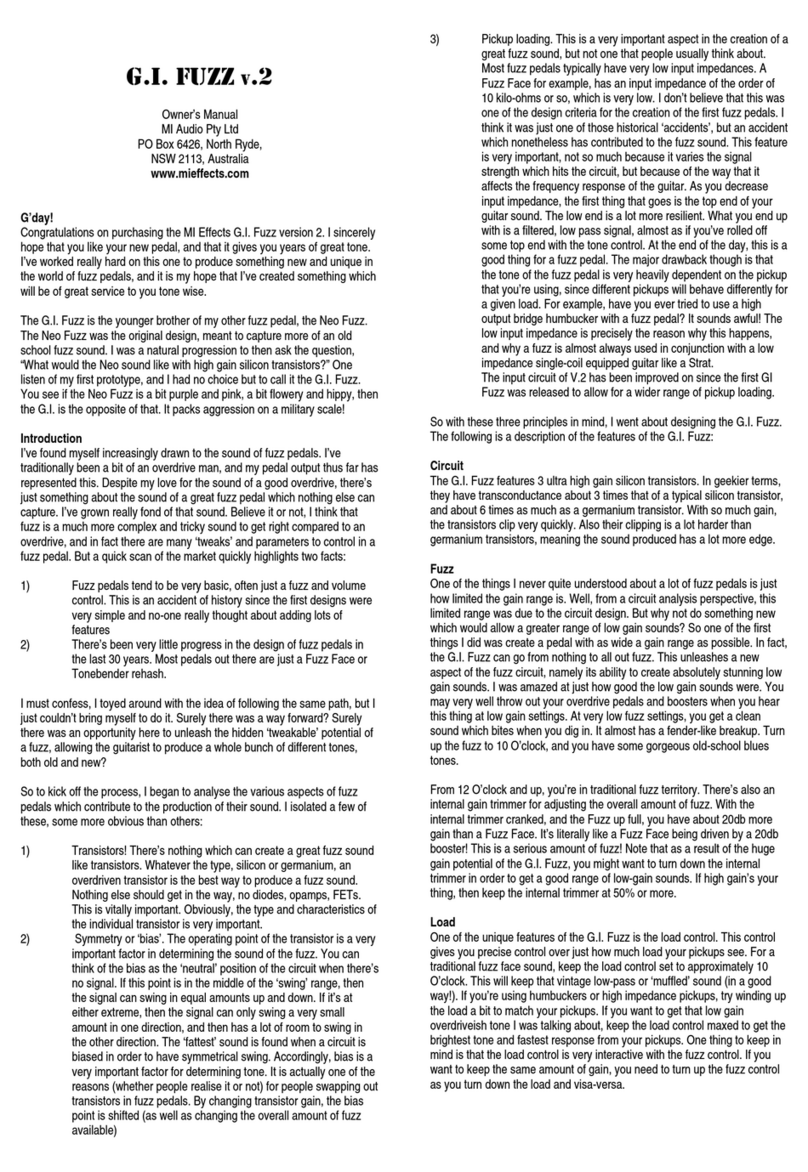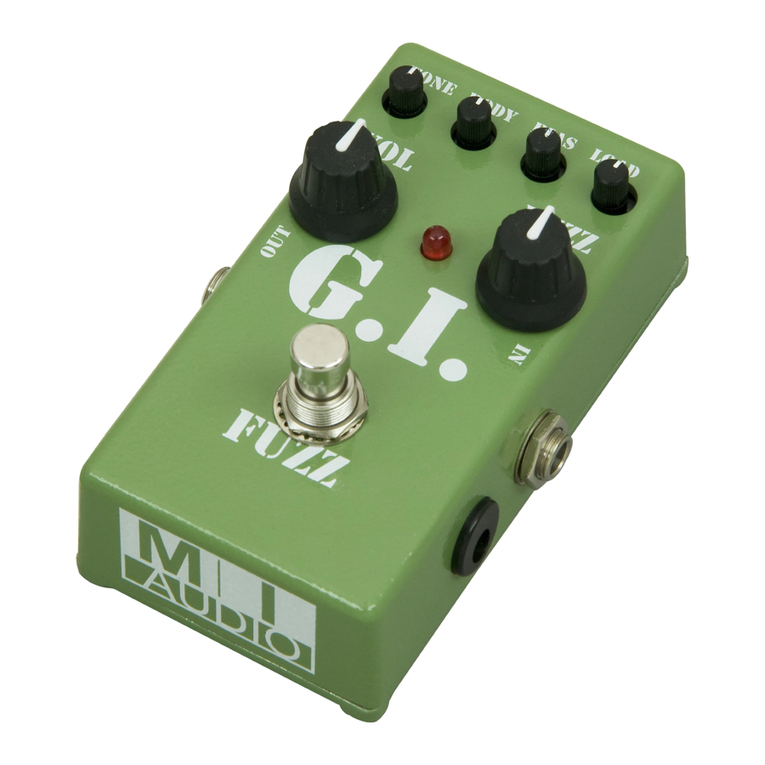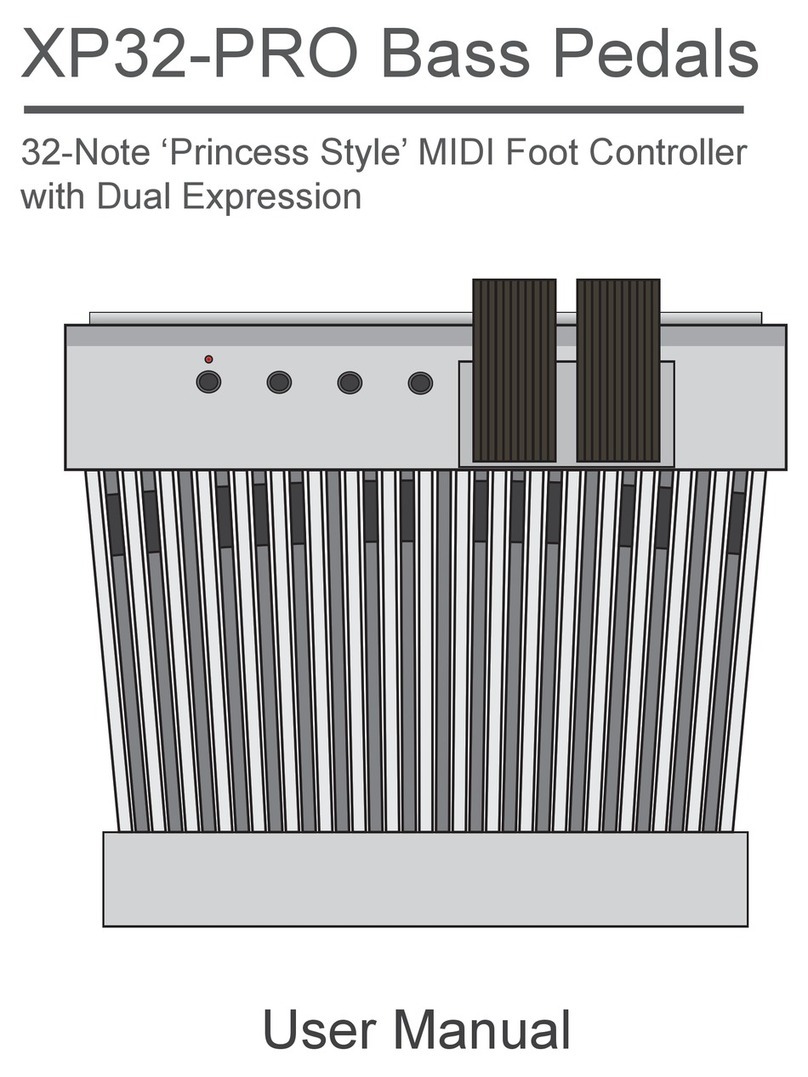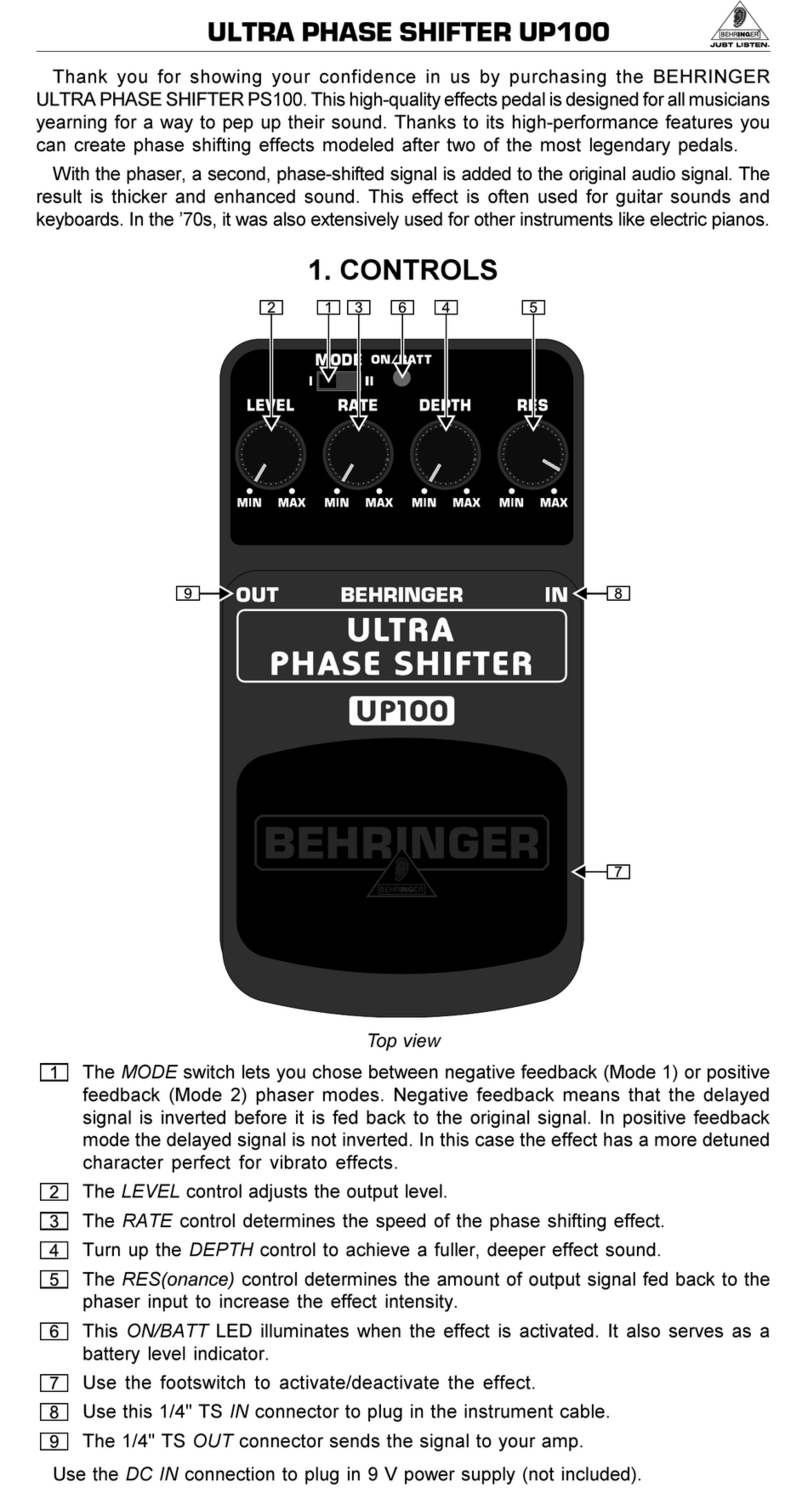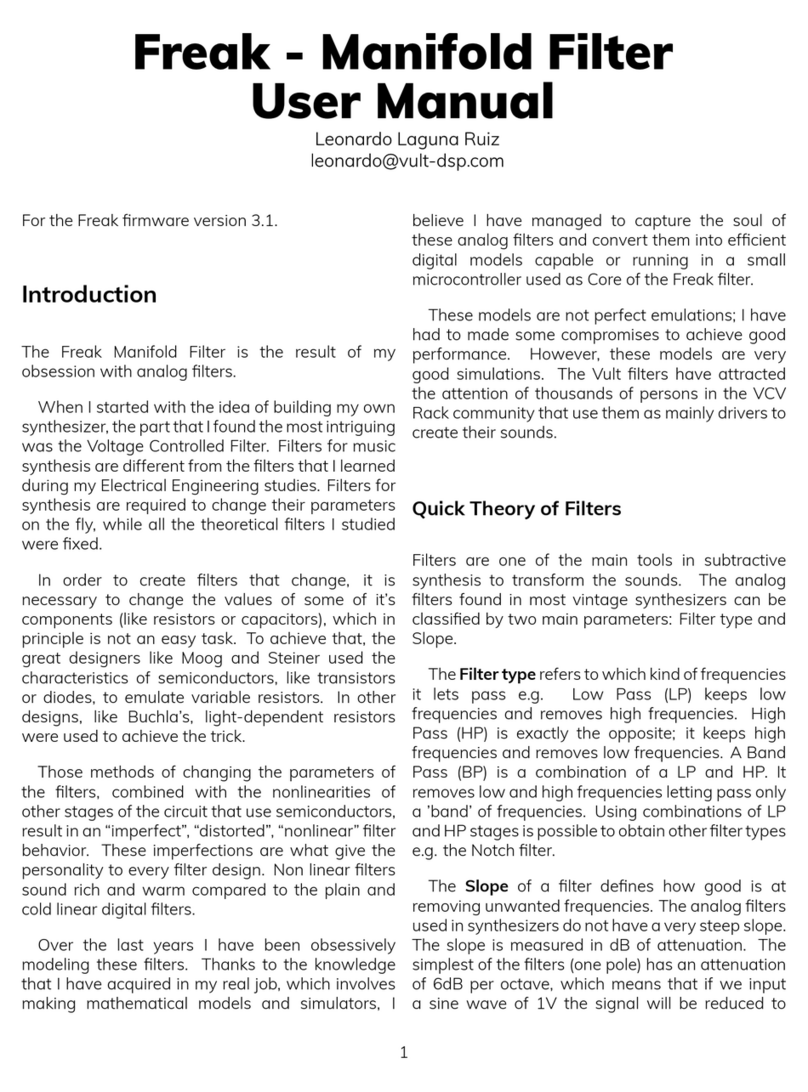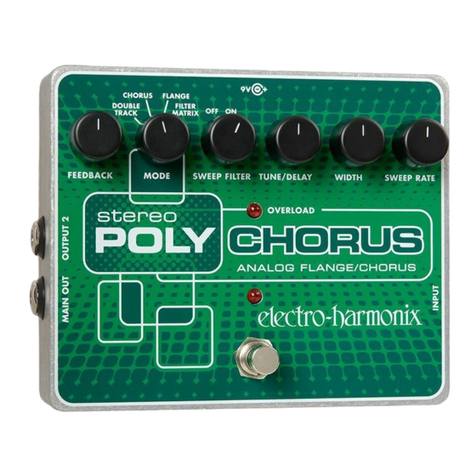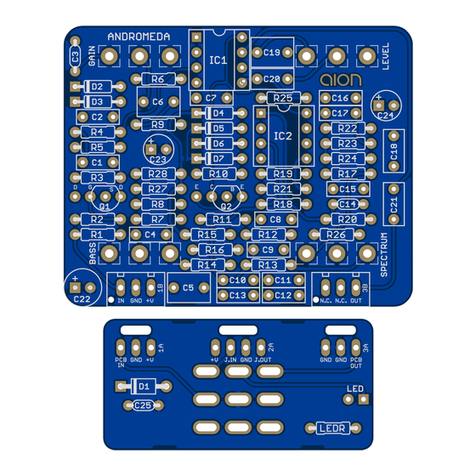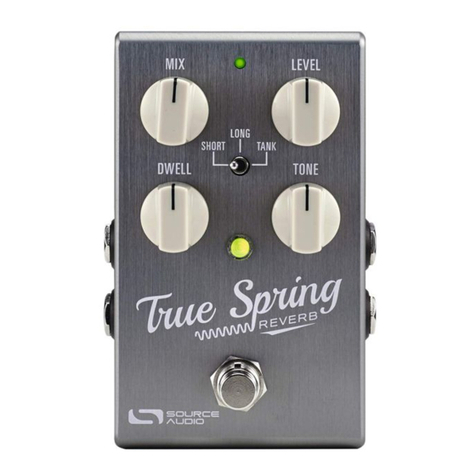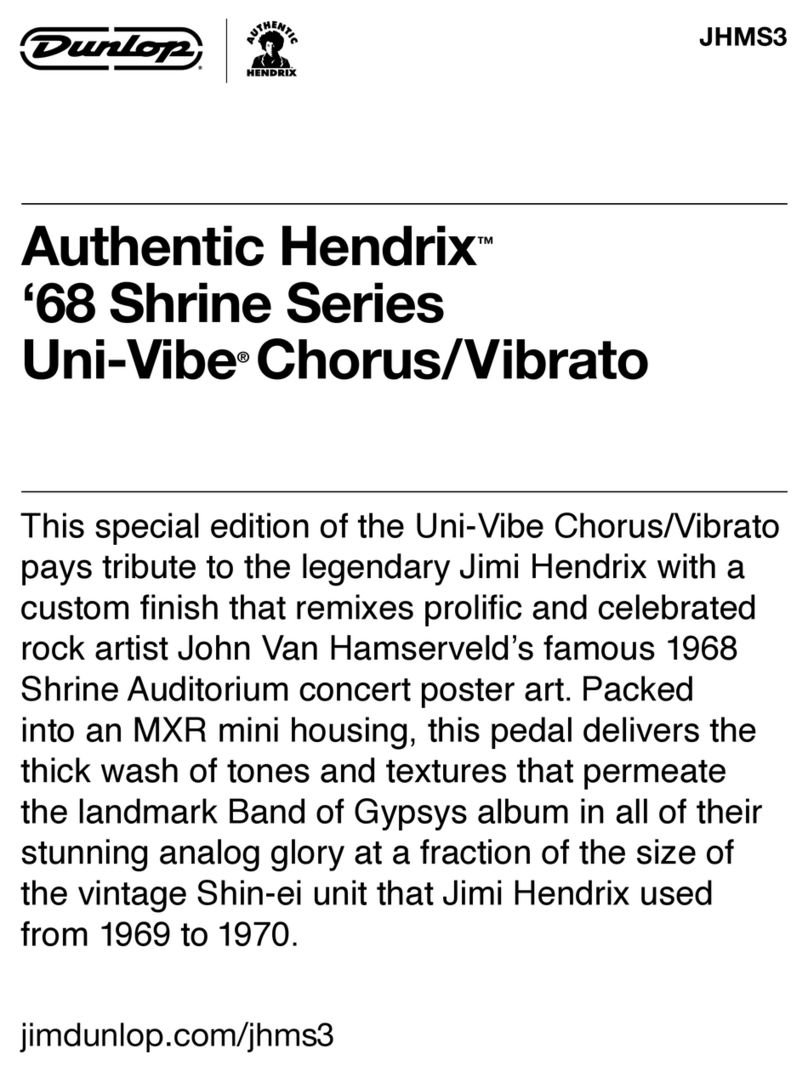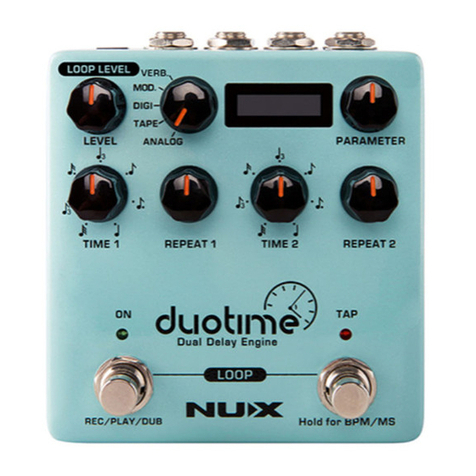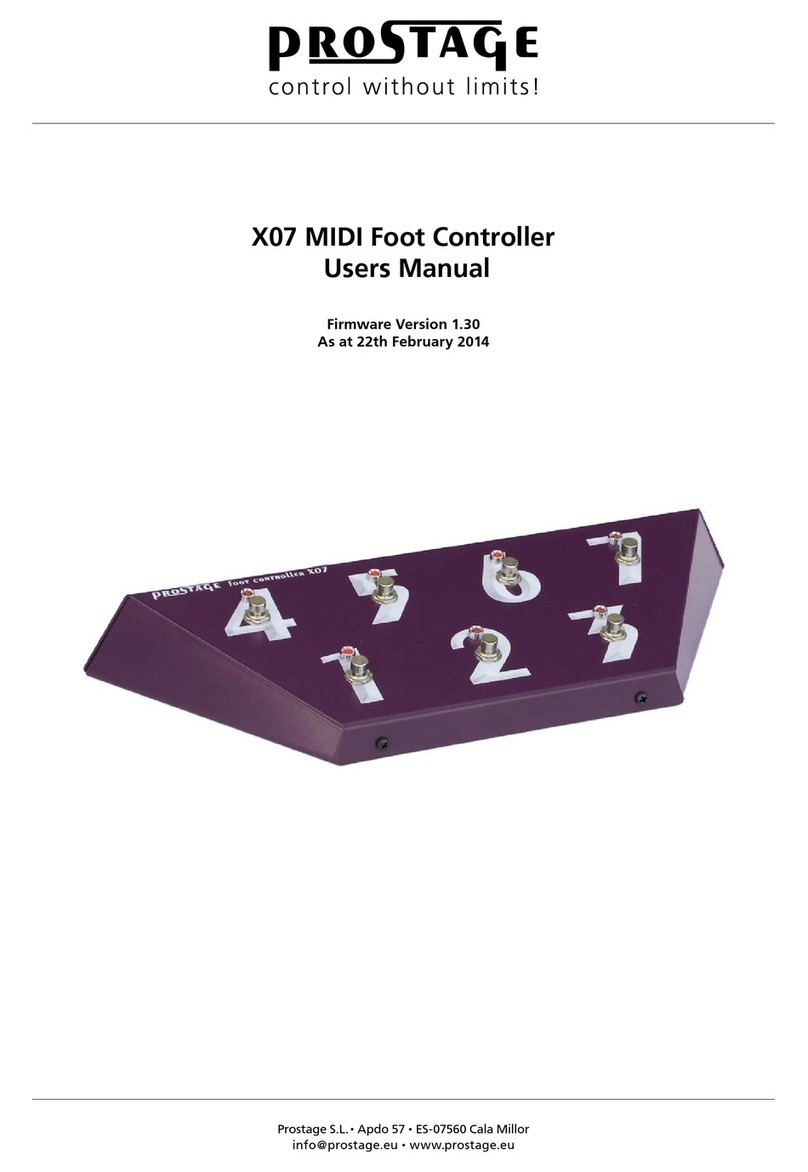MI-Audio Megalith Delta User manual

MI AUDIO PTY. LTD. P.O. Box 6426, North Ryde, NSW 2113 Australia http://www.mieffects.com
INTRODUCTION
G’Day! Congratulations on purchasing version one of the
new MI Effects Megalith Delta High Gain Distortion pedal. As
you may know, the Megalith Delta is part of the high gain MI
Audio voyage that all began with the MI Amplification
Megalith Beta 180W monster. It took some time for me to
really understand the variables behind great high gain tones,
but by designing the Megalith Beta from the ground up, I was
able to really grasp how to make a complex, sophisticated
high gain sound that kept all the nuances, huge bottom end
and the clarity and character of the top end. All of these
tricks and secrets have now passed onto pedal form, the
Megalith Delta.
The Megalith Delta pedal is a solid state 'model' of the Beta
preamp, using JFETs to simulate the gain stages of the
preamp valves. The transfer characteristics of FETs are very
tube-like, so it seemed that this was a great place to start.
However, making a FET stage behave like a particular tube
stage is a very complex affair. Often, it's just the exact same
circuit as the 'simulated' amp, but with FETs instead of tubes,
adjusted source or drain resistances, and 9V operation. Little
or no thought is often given to the operating points, dynamic
range, scaling of clipping thresholds, output impedances,
and intrinsic capacitances due to things like the miller effect
etc.
In a nutshell, I was able to feed all these parameters into the
Megalith Delta design, and come up with something which is
as close as humanly possible to the original. Because of this
attention to detail, I really feel the Delta will deliver all of the
brutal, articulate and sophisticated tones the Megalith name
has become synonymous with.
FEATURES
GAIN CONTROL
The Megalith Delta starts in mid-gain territory. THIS IS A
HIGH GAIN PEDAL! BACK AWAY NOW IF YOU ARE
SEARCHING FOR THE VINTAGE BLUES TONES! The
GAIN control offers a wide sweep in gain, from solid rock
tones, to serious crunch, to every dark shade of brutal
imaginable.
The stock, un-boosted tone is very fat in the low mids and is
the Megalith’s thickest tone. This is a great mode for getting
the punchiest rhythm sounds.
The GAIN control has a responsive interaction with each of
the three EQ options (EQ SWITCH, CONTOUR, and THREE
BAND EQ), allowing you to dial in, for example a slightly
woolly tone at minimum gain, and with flat-out brutality at
maximum.
GAIN BOOST
The second footswitch of the pedal, BOOST, takes the pedal
from a mid-gain base to its highest gain. This footswitch is
equivalent to flicking over to the HIGH GAIN setting on the
Megalith Beta amplifier. This BOOST mode not only adds
more gain, but also tightens the response up considerably,
with more of an upper mid emphasis.
I thought by adding this gain boost as a foot switch, it gives
you the option to really step up the crazy. I also figured that
mid to high switching was a lot more useful than low to high,
as there are already plenty of great options out there for the
lower gain sounds. Let’s face it, someone interested in the
Megalith Delta isn't going to be too stressed about missing
the low gain mode!
TIP: I recommend dialling in a mid-gain tone with gain
between 11 and 3 o’clock to get the most out of the BOOST
mode. This allows you to set up a rhythm/lead sound with the
added upper mids and tightness giving you extra harmonics
and saturation.
CONTOUR
The contour control is another unique feature of the Megalith
design .In the Megalith Beta amplifier; it affects the frequency
response of the phase inverter in the power amp. I went to a
lot of effort to recreate the CONTOUR control in the Megalith
Delta pedal to mimic this response by designing a phase-
inverter like stage, and integrating the CONTOUR control
into it.
Fully clock-wise, it’s fat and midrangy, with a slightly rolled
off top end. As the CONTOUR control is turned down, the
mids start to scoop out, and the sub-bass frequencies tighten
up. This is a great control for further refinement of the overall
high gain tone. You can also think of this as an alternate
midrange control. Try running the MID EQ control high and
the CONTOUR low (also adjusting the EQ shift), and visa
versa for a huge range of tones.
BASS, MIDDLE, TREBLE AND
EQ SHIFT SWITCH
The combinations of the EQ section will give an impressive
number of high gain sounds, just like the Megalith Beta
amplifier.

MI AUDIO PTY. LTD. P.O. Box 6426, North Ryde, NSW 2113 Australia http://www.mieffects.com
The first thing to note about the three-band EQ on the
Megalith Delta is that each control has a wider sweep than
your typical tone stack. Small changes to these controls can
have a large impact on the tone. They are also highly
interactive. That is why I recommend using this feature to
fine-tune your overall sound. Refer to “How To Dial In Your
Sound” later in this manual.
The three position EQ SHIFT SWITCH is a unique feature of
the Megalith’s tone controls. This switch shifts the EQ’s
bands, allowing you to control different frequencies. Each
position has a particular signature tone, and is useful for
different things. The middle position “0” shifts the midrange
up, and adds quite a bit of low-mids to the sound. This is
great for really fattening up the tone, and works particularly
well with boost pedals. Position “1” voices the tone stack
closer to a traditional British voicing. There’s still a good
amount of midrange in the tone, but the tone is more
balanced. Position “2” is more of a traditional American
voicing, with a more scooped and shifted midrange.
A tip for live playing is to use only as much bass as you
need. Going easy on the bass will help keep your tone tight,
and by keeping a healthy amount of mids and treble, you will
sit better in the mix.
OUTPUT SECTION
A big part of the Megalith Beta amplifier's huge gain sound is
the 160 Watts of headroom! Of course, this would always be
the limitation in trying to emulate a high gain amplifier to
stomp box form. But by adding voltage doubling circuitry in
the Megalith Delta pedal, it allows the 9V supplied by battery,
or DC adaptor, to be increased to 18V within the pedal's
circuitry. This has the advantage of producing the crushing
low end without mush, much like the 160W output of the
Megalith Beta does at the amp level.
Finally, I designed an output section which is designed to
'compensate' for the standard guitar amp's clean channel
response, so that when you plug the Megalith pedal into a
'reference' clean amp, you get something close to the feel of
the Megalith Beta. Having said that, one of the main aspects
of the Megalith Beta's 'presence' is the sheer headroom and
output power it has. So no, you probably won't unleash
carnage and devastation plugging a Megalith Delta into a 5W
lunch-box amp. That's just the physics of it,... a reality more
inviolable than the existence of fragile harmonics in a crystal
lattice.
HOW TO DIAL IN YOUR SOUND
This section aims to guide you through dialling in a full metal
sound straight away after pulling the Megalith Delta out of
the box. If you are a true brutal, death-metal, dragon-slaying
guitar god, you would have thrown out the manual by now,
but for those still reading follow these few steps. It’s a good
idea to start with everything at 12 O’clock, with the EQ Shift
set to “1”. From there, follow this sequence:
If you require more low mids, set the EQ shift to “0”. If
you need less, set it to “2”.
Adjust the CONTOUR control to adjust the body of the
tone; clockwise brings in more mids and gives a fat, vintage
tone, anti-clockwise scoops the mids for a modern, tight
chug. As you pull the CONTOUR back and the mids
decrease, compensate by increasing the VOLUME control.
Set the GAIN between 11 and 3 with BOOST off. This
will give you the most out of the BOOST mode.
Finally, use the three band EQ to fine tune the tone.
POWERING THE PEDAL
PLEASE READ CAREFULLY!!!
THE MEGALITH DELTA PEDAL RUNS OFF 9V
ONLY. REPEAT. ONLY USE A 9V BATTERY OR 9V
DC POWER ADAPTOR.
The Megalith Delta is designed for 9v, and will not run better
at higher voltages (for technical reasons). In fact you can
cause damage to the circuit if a higher voltage is applied.
The 9 volt DC port (which accepts a standard barrel jack with
a Negative centre pin.) or 9V battery may be used. If using
battery to power the Megalith Delta, and the pedal begins to
sound different, please monitor the voltage of the battery with
a multimeter and/or replace the battery with a new one.
If using a battery, the pedal is powered when a plug is
inserted into the input jack. So when not in use, disconnect
the input plug to maximise battery life.
To access the battery, unscrew the 4 screws at the bottom of
the pedal and remove the bottom plate.
REGISTRATION & WARRANTY
To register your pedal, you can email your name, contact
details, purchase date, and retailer details along with the
Alternatively, you can send the above information to the
postal address on the front of this manual. PLEASE
REGISTER YOUR PEDAL. In the long run, it will be difficult
to have your pedal serviced if you need to if the pedal is not
registered.
This pedal carries a 5 year warranty that covers all repairs
due to manufacturer error. It does not cover any damage due
to user mishandling, shipping, acts of God, and abuse. The
owner should contact MI Audio directly for all repairs, and
any work done by anyone other than MI Audio voids the
warranty. All shipping costs are the responsibility of the
owner, and are to be paid in advance of any work performed
on the pedal. The owner may be asked to provide a copy of
the sales receipt for verification.
DISCLAIMER
The owner or user assumes responsibility for death, injury
and/or damages relating to the operation of this device. MI
audio assumes no responsibility for death, injury or damages
relating from the operation of this device. I am always
thinking of ways to improve things, so all specifications are
subject to change without notice.
STAY BRUTAL \m/
Once again, I hope you enjoy the Megalith Delta high gain
distortion. Please feel free to contact me with product
feedback (excuse the pun), or for any general enquiries.
Other MI-Audio Music Pedal manuals
Popular Music Pedal manuals by other brands
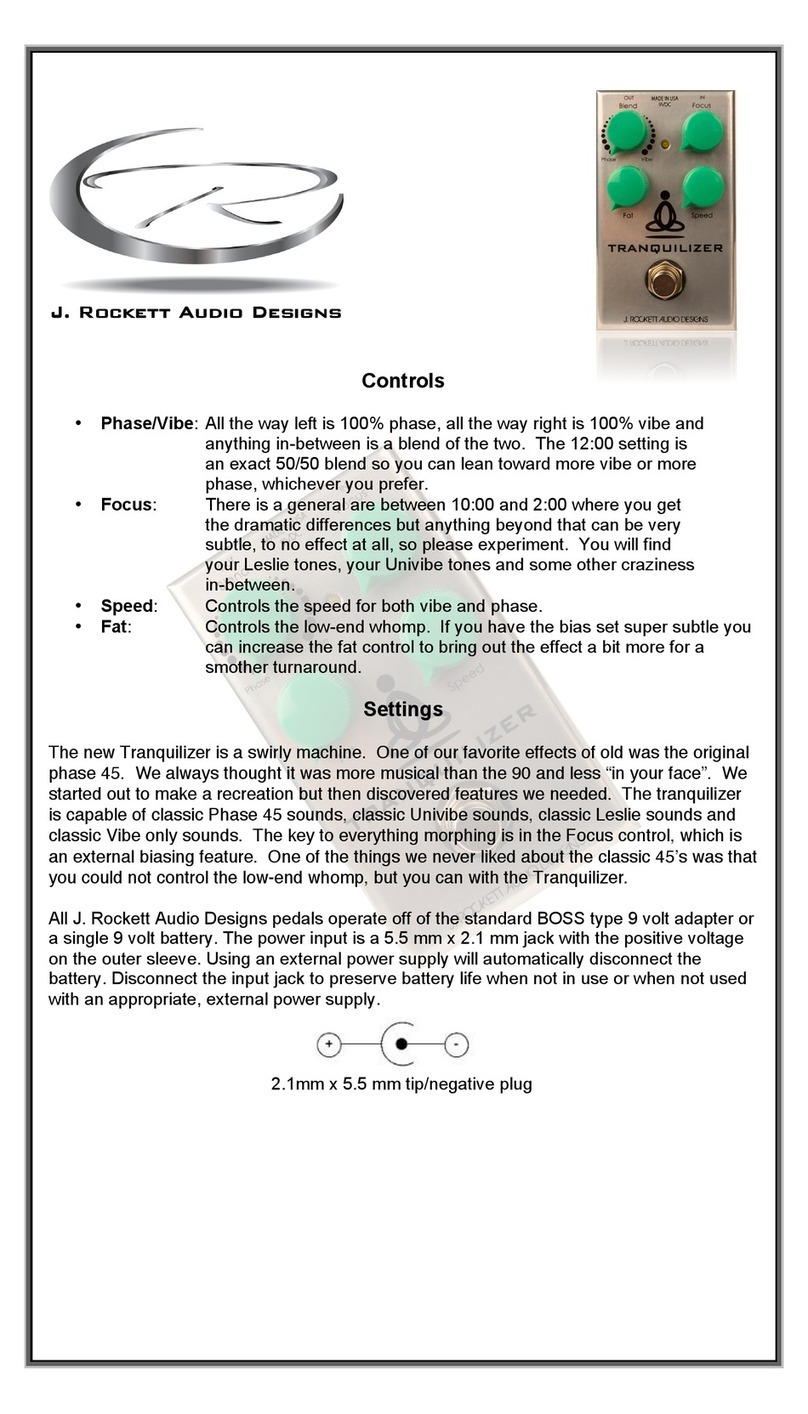
J. Rockett Audio Designs
J. Rockett Audio Designs Tranquilizer manual
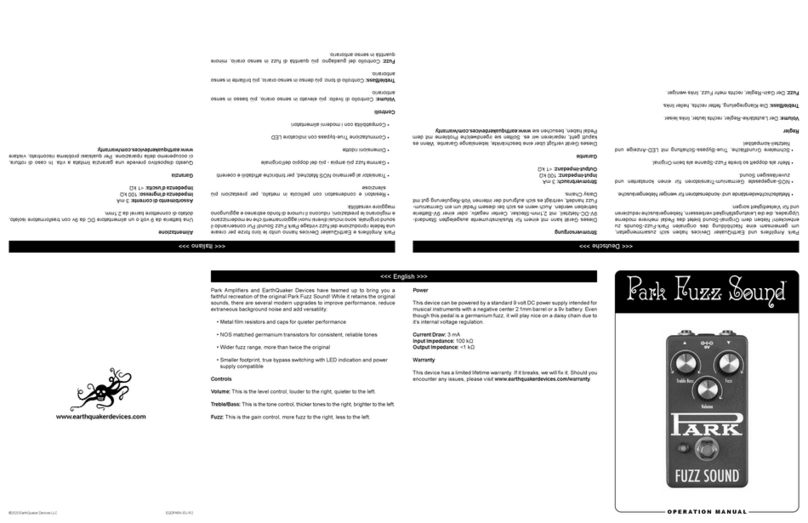
EarthQuaker Devices
EarthQuaker Devices Park Fuzz Sound Operation manual

pigtronix
pigtronix Echolution 2 Ultra Pro user guide

MoltenVoltage
MoltenVoltage Sixy owner's manual
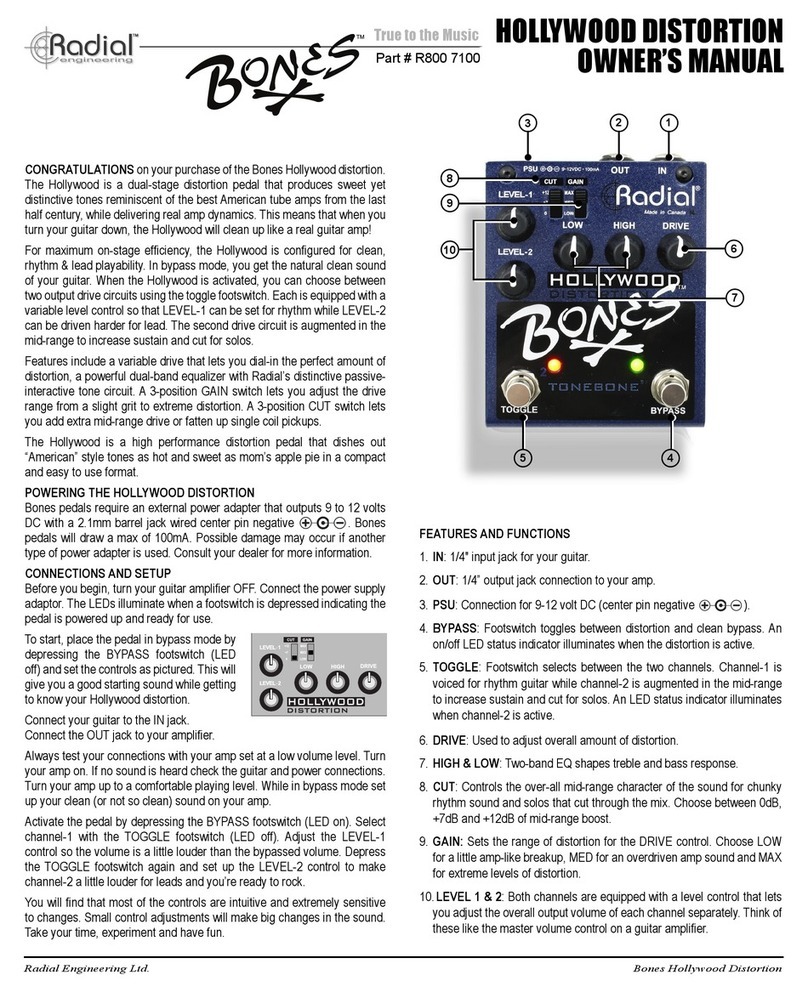
Radial Engineering
Radial Engineering Bones Holywood owner's manual

Shadow
Shadow SH Hex Pedal installation instructions

